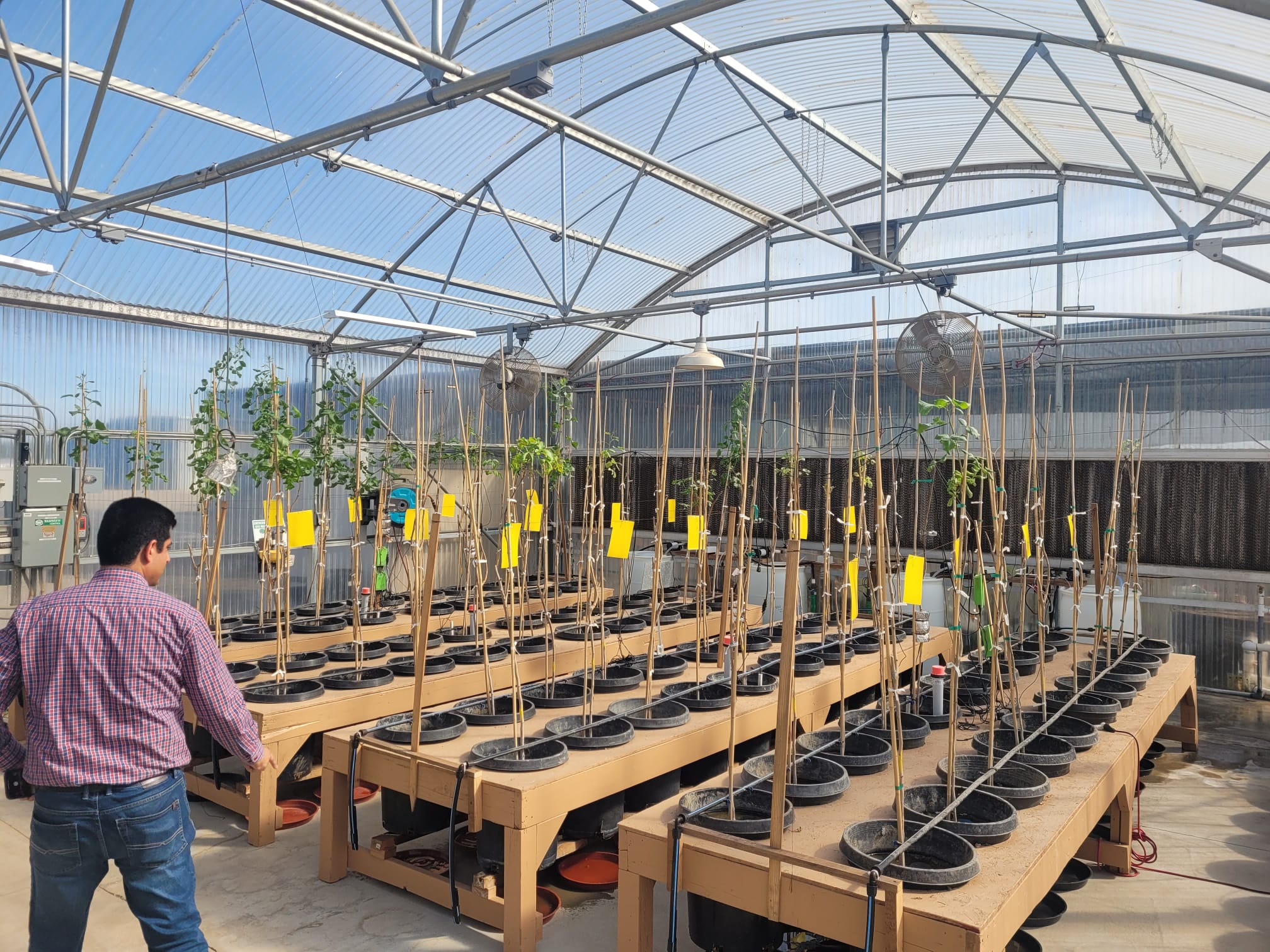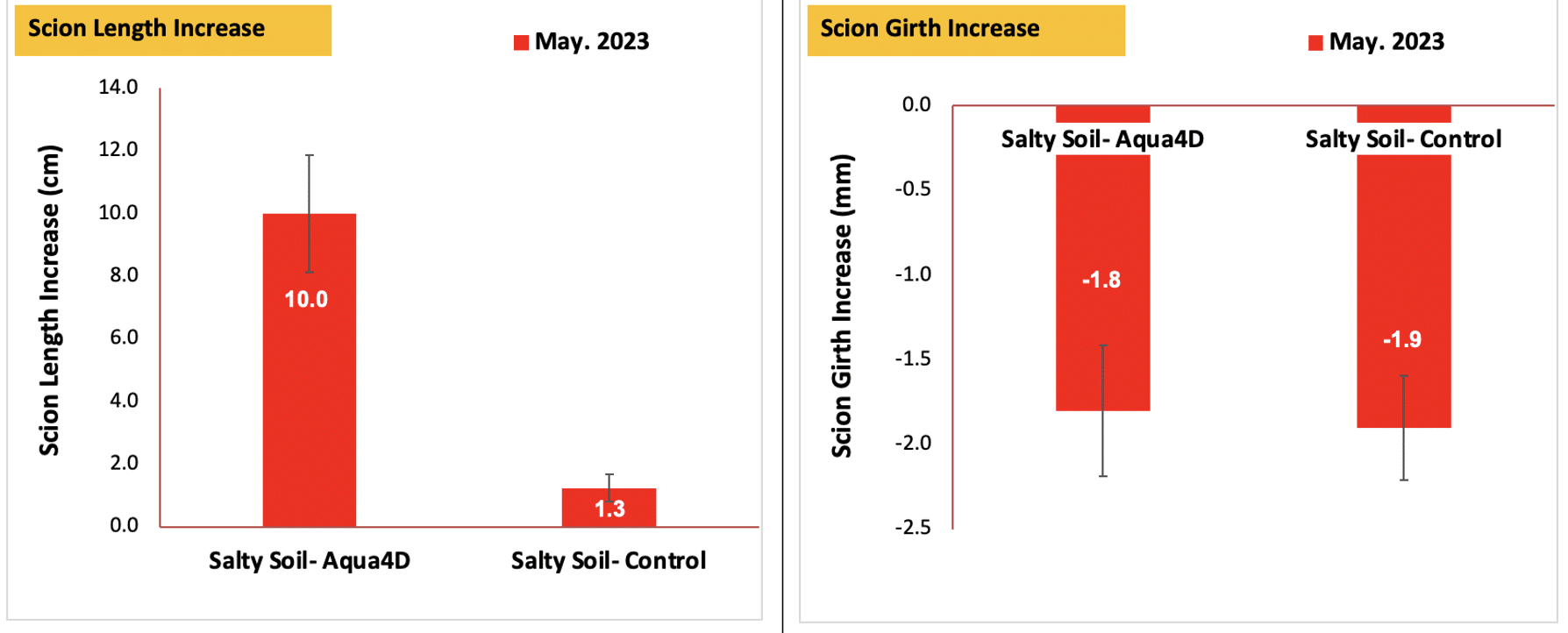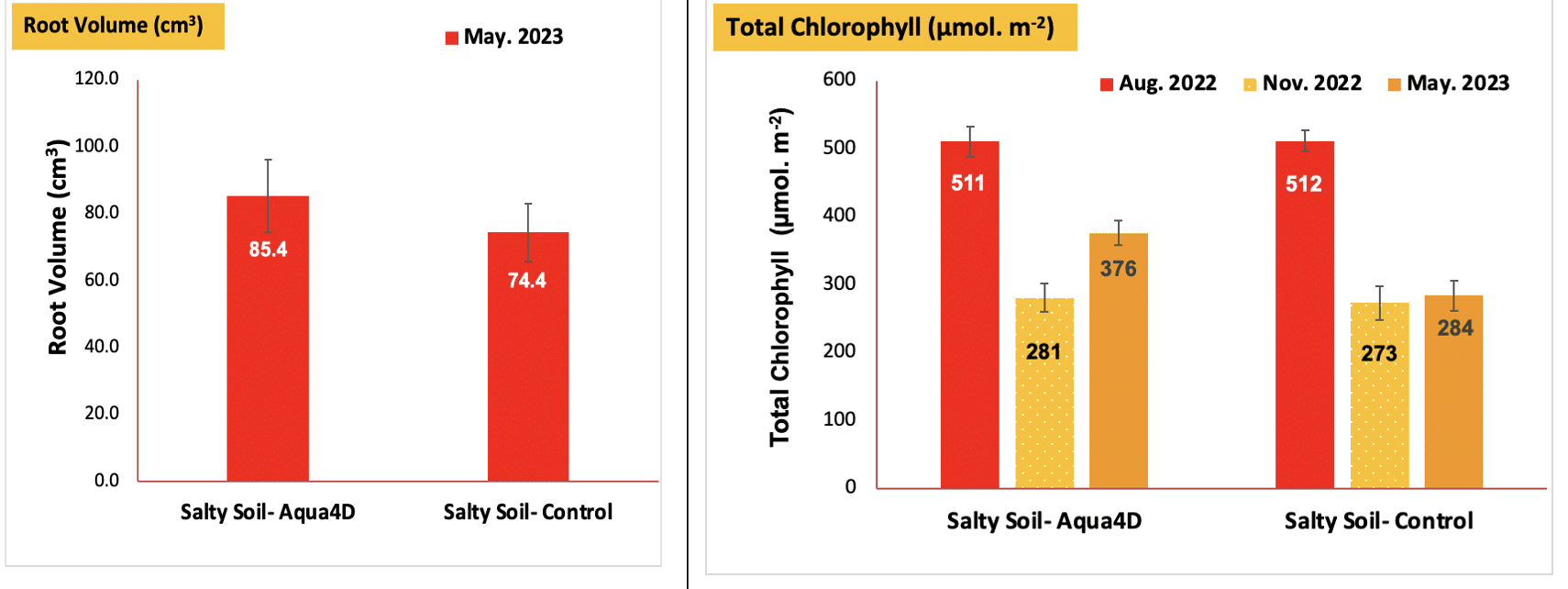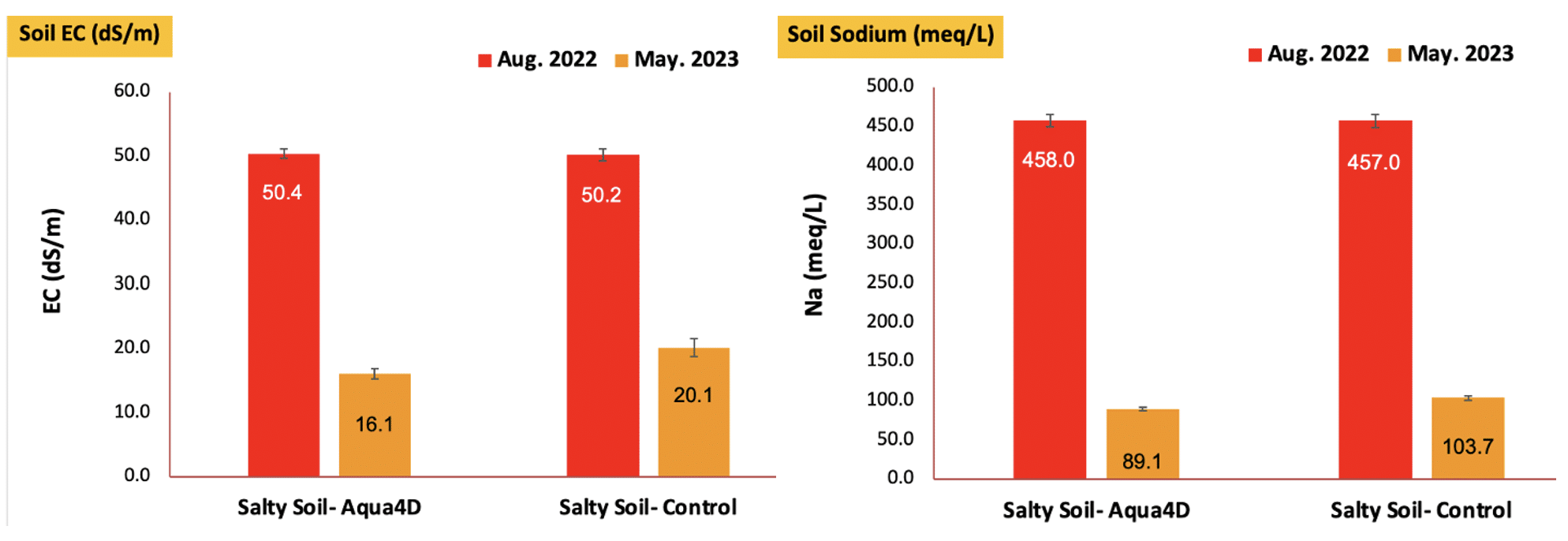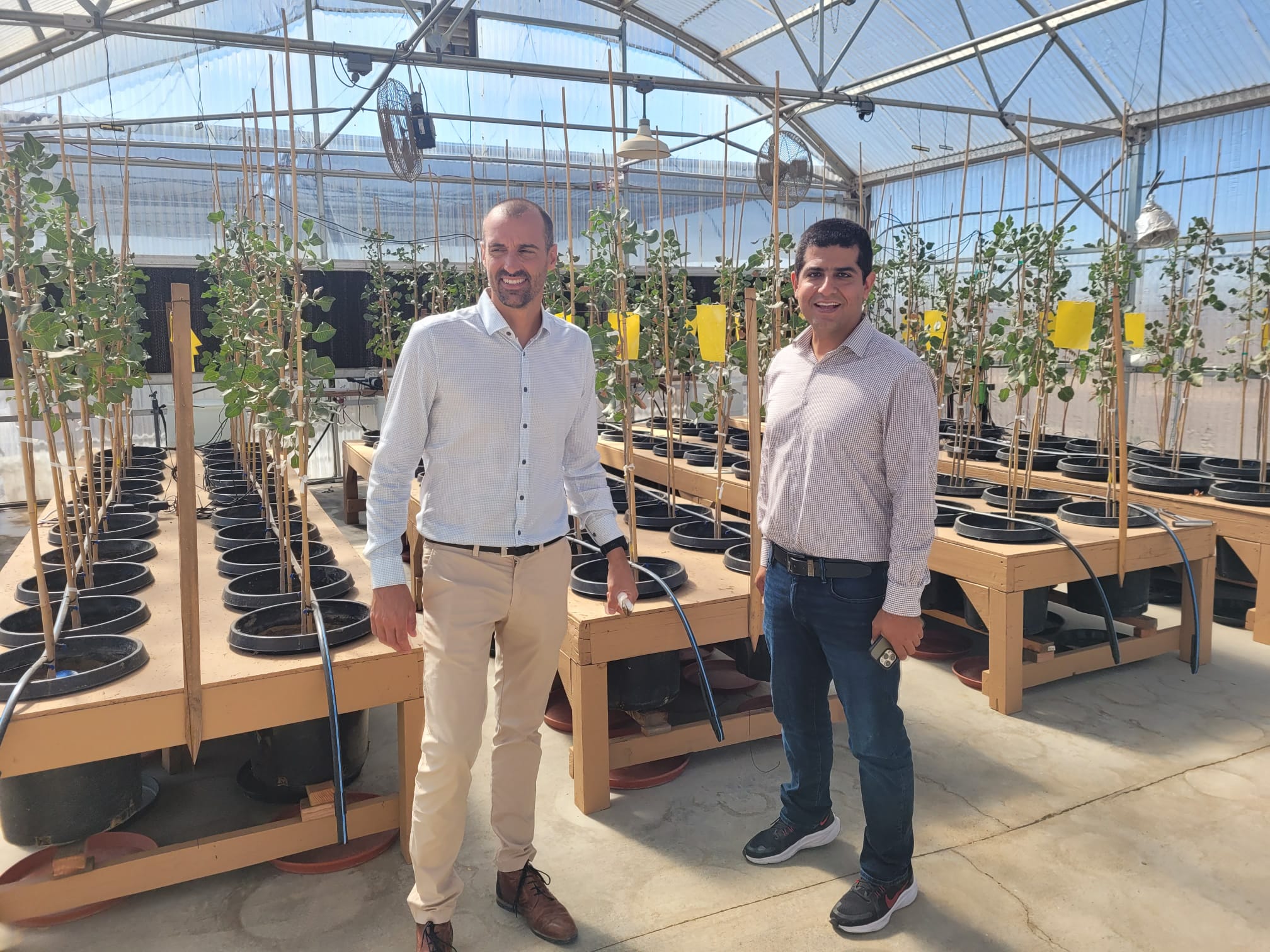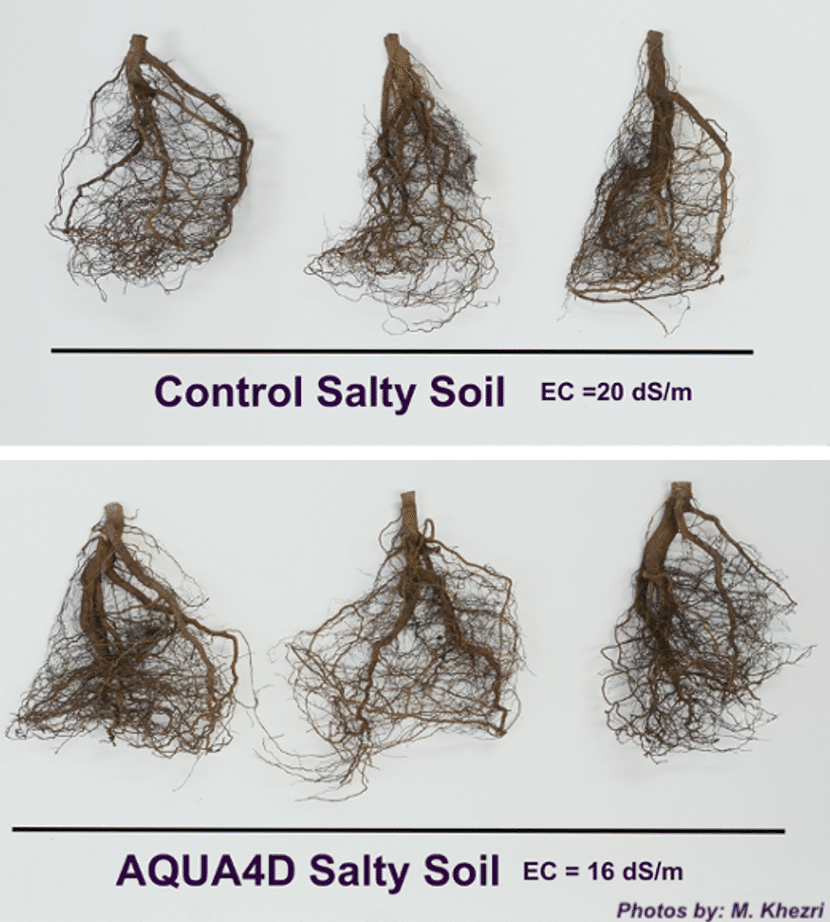The pistachio industry faces significant challenges associated with limited water availability and high soil salinity, which can have detrimental effects on tree growth, crop productivity and sustainability. AQUA4D® technology has emerged as a potential solution to improve tree growth, soil conditions and optimize water use efficiency. This study, conducted in Fresno, CA, looked at the impact of this technology on plant morphological and physiological parameters, nutrient uptake, and soil characteristics in salty soil conditions.
In brief:
- ✅ AQUA4D® proved effective in treating salty soils;
- ✅ AQUA4D® boosted water uptake and reduced EC, sodium, chloride, & boron in soil, indicating successful leaching of harmful salts;
- ✅ The survival rates of plants and tree growth parameters were significantly improved in the AQUA4D-treated soil;
- ✅ Summary: “AQUA4D® treatment can effectively alleviate salt stress and enhance plant performance in saline soil conditions.”
Introduction
Salinity affects agriculture in arid climates throughout the world, putting environmental sustainability and agricultural crop productivity at risk and degrading soil resources. Saline conditions negatively impacts morphological and biochemical functions in plants and disturbs plant growth, development, and yield (Zhang and Dai, 2019). When toxic concentrations of (chloride) Cl- or Boron (B) occur in plant leaves, it appears as yellowing and progresses to burning along the leaf edges. This reduces photosynthesis, transpiration, and gaseous exchange and reduces the leaf water potential. (Leinfelder-Miles, 2018; Zhao et al., 2020).
In California’s Central Valley, soil salinization processes also occur in dryland regions, where soils frequently have high levels of salts and boron in the soil and leaf tissue. Unlike other fruit trees, pistachio is moderately tolerant to sodium, chloride and boron. However, salts and boron, when excessive, may cause significant leaf injury, defoliation and yield loss (Ferguson and Kallsen, 2016).
Having already shown success in the region, this research looked at the effects of AQUA4D® technology on various plant and soil parameters in salty soil conditions, providing valuable insights for pistachio growers seeking sustainable solutions. Conducting this research in a greenhouse environment provided a controlled setting and precise monitoring of the technology’s effects.
Growers can utilize these results to make informed decisions regarding the adoption of AQUA4D technology in field conditions, enhancing soil conditions, optimizing water use efficiency, and ultimately improving crop productivity.
Methods
The objectives of this study were to assess the AQUA4D system’s efficacy in saline soil conditions, characterized by elevated levels of electrical conductivity (EC), sodium (Na), chloride (Cl), and boron. The specific aims were to evaluate the leaching efficiency of Na, Cl, and Boron, diminish EC, and alleviate the detrimental effects of salts on the growth factors of the industry-standard ‘Golden Hills’ pistachio trees. Furthermore, the study sought to investigate the influence of AQUA4D on the tree’s xylem flow rate, leaf chlorophyll content, and concentrations of carbohydrates, macro, and micro-nutrients in main plant organs such as leaves, bark, and roots.
This research was carried out in an automated controlled greenhouse in Fresno, CA (36.720039, – 119.926770). For this research study, a salty soil with high EC (50.3 dS/m), Na (460 meq/L) and Cl (109 meq/L), Boron (16.6 ppm), SAR (112.7) and pH (8.2) was prepared. The salty soil for this experiment was obtained from a field in Bakersfield. Prior to the experiment, both the irrigation water and the soil underwent a full agricultural analysis. No fertilizers were applied to the soil or irrigation water during the greenhouse research.
In this experiment, conducted between August 2022 and June 2023, the following parameters were evaluated:
· Sap Flow and Soil moisture Analysis
· Plant Analysis:
Rootstock and Scion Growth | Total chlorophylls | Plant Biomass | Leaf electrolyte leakage
Carbohydrate analysis | Plant macro and micro nutrients | Non-survived Trees
· Soil Analysis
· Statistical Analysis
Results and discussion
Soil Moisture and Sap Flow Analysis:
In salty soil conditions, both the control and AQUA4D-treated soil had high concentrations of Na, Cl, and B, along with elevated electrical conductivity (EC) and sodium adsorption ratio (SAR). Our observation during the soil sampling from each individual pot revealed higher moisture content in AQUA4D-treated pots compared to untreated control ones. The sap flow measurements conducted during the final two weeks of the research project indicated that trees in AQUA4D-treated salty soil collected 4.1 gallons, while control trees only collected 0.2 gallons (see below). This substantial difference in sap flow confirms that AQUA4D-treated trees in salty soil experienced significantly higher water uptake compared to control trees.
Plant analysis :
AQUA4D-treated trees displayed significantly higher scion length, root dry weight, shoot and leaf fresh and dry weights, indicating the system’s effectiveness in promoting growth under high salt stress conditions. Furthermore, chlorophyll measurement confirmed significantly higher leaf chlorophyll contents in AQUA4D-treated trees, indicating an enhanced capacity for light absorption and utilization, leading to increased photosynthetic rates. This allows AQUA4D-treated trees in the salty soil conditions to thrive by generating more resources for vital physiological processes.
Ion leakage: Concerning direct effects on salinity, AQUA4D® treated trees exhibited significantly higher ion leakage percentages, indicating lower salt pressure compared to control trees. Moreover, the mortality percentage was considerably higher in control trees (85%) compared to AQUA4D® treated trees (55%), highlighting the system’s effectiveness in mitigating the negative effects of soil salinity.
Nutrients: The analysis of macro and micronutrients in leaf samples revealed compelling results. Notably, it was the elevated levels of leaf boron that played a prominent role in causing leaf burn and subsequent reduction in chlorophyll content. These findings highlight the efficacy of the AQUA4D® in mitigating the accumulation of detrimental elements, particularly boron, which leads to improved leaf health and chlorophyll levels. Moreover, the significant decrease in boron concentration observed in the leaves, bark, and roots of AQUA4D-treated trees further validates the effectiveness of the AQUA4D® system in preventing excessive boron accumulation throughout the plant. This shows AQUA4D® offers a promising solution to alleviate the potential toxic effects of boron, thereby fostering healthier overall plant development in challenging salty soil environments.
Sap flow: The remarkable improvement in tree sap flow due to AQUA4D® treatment is supported by observations of higher soil moisture levels during soil sampling. The increased sap flow in AQUA4D-treated trees leads us to conclude that AQUA4D® not only enhances soil moisture but also augments moisture uptake by the plants.
Soil Analysis
In this experiment, AQUA4D-treated soil exhibited significantly lower EC, sodium, chloride, and boron concentrations compared to control soil. This finding demonstrates the efficacy of the AQUA4D® system in reducing the harmful effects of soil salts. AQUA4D® treatment successfully mitigated the detrimental impact of high salt content, providing a more favorable environment for plant growth.
Conclusion
The results in this study showcased the effectiveness of AQUA4D® treatment in reducing salinity-related issues. AQUA4D-treated soil exhibited significantly lower electrical conductivity (EC), Sodium Absorption Ratio (SAR), sodium (Na), chloride (Cl), and boron (B) concentrations compared to control. This reduction in salt levels demonstrates the efficacy of Aqua4D in leaching out harmful salts. Furthermore, trees treated with AQUA4D® irrigation water in the salty soil condition showed a significantly higher number of survived trees compared to the control, indicating the ability of AQUA4D® to improve tree survival rates under high salinity conditions.
Moreover, AQUA4D® treatment demonstrated positive effects on tree growth parameters in the salty soil condition. The reduction in salinity levels, as facilitated by AQUA4D®, likely created a more favorable environment for plant growth, leading to improved tree growth parameters. This highlights the potential of AQUA4D® as an effective solution for enhancing tree growth and productivity in soils affected by high salinity.
Thanks to Masood Khezri & team at Malakan Agricultural Research Institute, Fresno CA

California
Water-Smart Agriculture
Precision Irrigation
“The reduction in salinity levels, as facilitated by AQUA4D®, likely created a more favorable environment for plant growth, leading to improved tree growth parameters. This highlights the potential of AQUA4D® as an effective solution for enhancing tree growth and productivity in soils affected by high salinity.”
– Masood Khezri, researcher
Malakan’s Masood Khezri with AQUA4D USA’s Yvain Mirabal
Visual comparison of control vs AQUA4D rootstock



